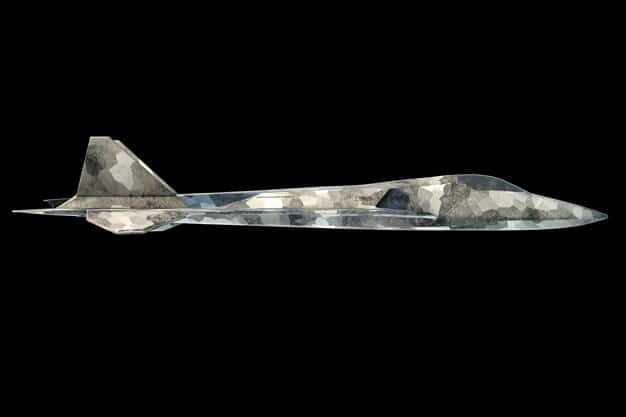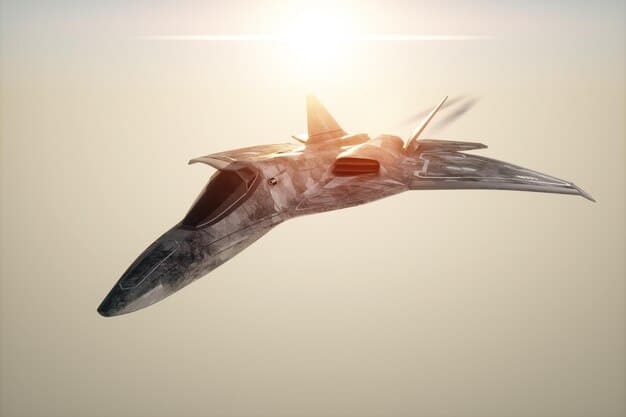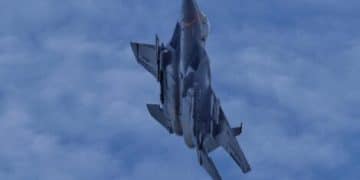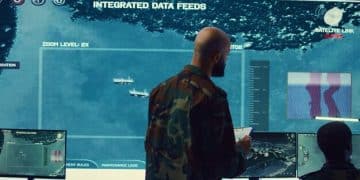US Air Force NGAD Fighter: Projected Benefits Unveiled

The US Air Force’s Next Generation Air Dominance fighter program is projected to deliver unparalleled benefits, including enhanced stealth, advanced networked capabilities, and superior lethality, designed to ensure air superiority against evolving threats in the 2030s and beyond.
The landscape of aerial warfare is relentlessly evolving, pushing the boundaries of technology and strategy. In this dynamic environment, the US Air Force’s Next Generation Air Dominance (NGAD) program emerges as a pivotal initiative, promising to redefine air combat for decades to come. But what are the projected benefits of the US Air Force’s Next Generation Air Dominance fighter? This ambitious endeavor aims to integrate cutting-edge technologies into a versatile system, securing a decisive advantage in an increasingly contested airspace.
Redefining Air Superiority: A Foundational Shift in Combat Capability
The concept of air superiority has long been central to military doctrine, enabling freedom of action across domains. However, near-peer adversaries have heavily invested in sophisticated air defense systems and advanced fighter aircraft, challenging traditional methods of maintaining aerial dominance. The NGAD program is not merely an incremental upgrade; it represents a fundamental rethinking of how the US Air Force will achieve and maintain air superiority in complex, high-threat environments. This involves moving beyond the isolated performance metrics of individual aircraft towards a more integrated, networked approach.
The core of NGAD’s philosophy lies in its “family of systems” concept. This means the fighter will not operate in isolation but will be a central node within a broader ecosystem of interconnected platforms, sensors, and capabilities. These range from unmanned loyal wingmen to advanced communication networks and sophisticated command-and-control systems. This synergistic approach aims to multiply the effectiveness of each component, creating a vastly more capable and resilient combat force compared to relying solely on a single, highly advanced manned aircraft. The emphasis shifts from platform-centric operations to network-centric warfare, where information and coordinated action are paramount.
Integrated Stealth and Survivability
One of the most critical aspects of the NGAD fighter will undoubtedly be its unparalleled stealth capabilities. While previous generations of stealth aircraft, like the F-22 and F-35, significantly reduced radar cross-sections, NGAD is expected to elevate this to an entirely new level. This includes not only all-aspect broadband stealth against a wider range of radar frequencies but also signature reduction across multiple domains, including infrared, acoustic, and even radio frequency emissions. Such advanced stealth is essential for penetrating highly contested airspace and operating undetected in environments saturated with advanced sensors and anti-access/area denial (A2/AD) capabilities.
* Next-generation signature management to evade detection.
* Enhanced electronic warfare suites for self-protection and offensive capabilities.
* Integrated defensive systems against sophisticated missile threats.
Beyond traditional stealth, NGAD is expected to incorporate advanced survivability features. This could include hardened airframes, redundant systems, and sophisticated damage assessment and mitigation technologies. The goal is to ensure the aircraft can withstand battle damage and continue its mission or safely return to base, minimizing attrition in high-intensity conflicts. This focus on survivability extends to cyber resilience, protecting the aircraft’s complex systems from digital attacks and ensuring operational integrity in a contested electromagnetic spectrum.
Advanced Networked Capabilities: The Brain of Air Dominance
The true revolutionary potential of NGAD lies in its projected networked capabilities. This fighter is envisioned as a central nervous system for airborne operations, acting as an advanced data fusion hub that gathers, processes, and disseminates information across the battlespace. Unlike current platforms, which may have limited data sharing capabilities, NGAD is designed from the ground up for seamless, high-bandwidth communication and information exchange with a myriad of other assets. This includes satellite networks, ground-based systems, naval assets, and other airborne platforms, both manned and unmanned.
This unparalleled connectivity will provide pilots with a vastly expanded and real-time common operating picture. They will have access to a wealth of sensor data from various sources, allowing for more informed decision-making and a deeper understanding of the battlefield. The ability to share this data instantly with other friendly forces means that threats can be identified and engaged more rapidly, and resources can be allocated more efficiently. This collective intelligence environment enhances situational awareness for all participants, transforming individual engagements into coordinated campaigns.
Secure and Resilient Data Links
The effectiveness of such networked operations hinges on robust, secure, and resilient data links. NGAD will likely incorporate multi-frequency, jam-resistant, and low-probability-of-intercept/detection (LPI/LPD) communication systems. These advanced links are crucial for maintaining connectivity and preventing adversaries from disrupting or exploiting communication pathways, ensuring the continuous flow of critical information even in heavily contested electromagnetic environments. The system will be designed to dynamically adapt to varying jamming conditions and redirect data through alternative channels if necessary.
* High-bandwidth, low-latency data transfer across diverse platforms.
* Jam-resistant and cyber-secure communication protocols.
* Real-time data fusion from multiple intelligence sources.
Furthermore, these networks will enable distributed lethality. Instead of a single platform carrying all the necessary weapons, NGAD could queue up targets for other less stealthy or more heavily armed assets, acting as an advanced forward observer or a command node for unmanned combat aerial vehicles (UCAVs). This distributed approach reduces the risk to individual manned platforms while maximizing overall combat effectiveness, making the entire force more lethal and adaptable.
Superior Lethality and Weapon Integration: Striking with Precision
At its core, a fighter aircraft exists to deliver combat power. The NGAD fighter is expected to possess superior lethality, achieved through a combination of advanced offensive and defensive weapon systems. This includes the capability to carry a wider range of current and future air-to-air and air-to-ground munitions, potentially leveraging internal bays for stealth purposes and external hardpoints for less contested environments. The design will likely prioritize flexibility, allowing for rapid adaptation to new weapon technologies as they emerge.
The integration of next-generation weapons, possibly including directed energy weapons (DEWs) or advanced hypersonic missiles, is a distinct possibility. While still in early stages of development, the NGAD platform is being designed with the modularity and power generation capacity required to accommodate such revolutionary systems. This future-proofing aspect ensures the aircraft remains relevant and dominant well into the latter half of the 21st century. The ability to launch a variety of weapons, both kinetic and non-kinetic, from a stealthy platform will give the US Air Force a significant tactical advantage.
Beyond-Visual-Range Engagement and AI-Enhanced Combat
A key projected benefit is an unparalleled ability to engage targets at extremely long ranges, well beyond visual range (BVR). This will be facilitated by advanced sensors, robust networking, and potentially new long-range air-to-air missiles. Such capabilities allow the NGAD fighter to dominate engagements from a distance, minimizing risk to the platform and pilot while dictating the terms of engagement. The integration of advanced artificial intelligence (AI) will play a crucial role in this process, assisting pilots in target identification, threat assessment, and optimal weapon selection.
* Capacity for next-generation air-to-air and air-to-ground precision munitions.
* Potential for directed energy weapon integration.
* Enhanced beyond-visual-range combat capabilities.
AI will not only enhance combat effectiveness but also potentially reduce pilot workload, allowing them to focus on high-level strategic decision-making. AI algorithms could manage complex sensor fusion, tactical maneuvers, and even predict adversary actions, offering unparalleled levels of automation and decision support. This human-AI teaming aims to create a cognitive advantage over adversaries, allowing for faster and more effective responses in dynamic combat scenarios.

Modular Open Systems Architecture (MOSA): Adaptability for the Future
One of the less visible but equally critical benefits of the NGAD program is its commitment to a Modular Open Systems Architecture (MOSA). This design philosophy moves away from proprietary, bespoke systems prevalent in older aircraft, favoring standardized interfaces and interchangeable components. The implications for future readiness and cost-efficiency are profound. A MOSA approach allows for rapid upgrades, integration of new technologies, and easier maintenance, significantly reducing the notoriously long and expensive development cycles typically associated with military aviation.
By adhering to open standards, different manufacturers can contribute components and software, fostering competition and innovation. This also means that as new threats emerge or new technologies become available, they can be more easily incorporated into the NGAD platform without requiring a complete redesign of the aircraft. This agility is vital in an era of rapid technological change, ensuring that the US Air Force’s premier fighter remains at the cutting edge for its entire operational lifespan, rather than becoming obsolete prematurely.
Reduced Cost of Upgrades and Maintenance
Historically, upgrading military aircraft has been a time-consuming and prohibitively expensive process, often requiring extensive re-certification and complex integration efforts. MOSA aims to dramatically lower these barriers. New sensors, processors, communication modules, or weapon systems could theoretically be “plug-and-play,” allowing for quicker fielding of enhanced capabilities. This not only saves money but also ensures that the fleet can react swiftly to unforeseen changes in the strategic environment, maintaining a qualitative edge without lengthy downtimes.
* Standardized interfaces for rapid technology insertion.
* Reduced lifetime maintenance and upgrade costs.
* Enhanced interoperability with emerging systems.
The MOSA also promotes greater software commonality across different platforms, potentially creating a more cohesive and adaptable interconnected force. This shared architectural foundation facilitates joint development and operations, simplifying training and logistics. It also makes the ecosystem more resilient to cyber threats, as updates and patches can be deployed across a standardized framework more efficiently.
Pilot Cognitive Offload and Human-Machine Teaming: Elevating Human Performance
Modern air combat is characterized by an overwhelming amount of information and split-second decisions. The NGAD fighter aims to address this challenge by significantly optimizing pilot workload through advanced automation and human-machine teaming (HMT). This means that while a human pilot remains in the loop for critical decision-making, many routine, data-intensive, or high-speed tasks will be offloaded to intelligent autonomous systems. This frees the pilot to focus on the strategic picture, complex problem-solving, and the overall tactical execution of the mission.
Advanced sensor fusion, AI-driven threat assessment, and augmented reality (AR) displays within the cockpit will present critical information in an intuitive, digestible format. Pilots will not be merely flying the aircraft; they will be commanding a complex, intelligent system. The goal is to enhance the pilot’s cognitive capacity, allowing them to process more information, make faster and more accurate decisions, and ultimately perform at a higher level than ever before possible.
Loyal Wingman Integration and Autonomous Support
A prime example of HMT in NGAD is the concept of “loyal wingmen” – unmanned combat aerial vehicles (UCAVs) that operate semi-autonomously alongside the manned fighter. These wingmen can perform dangerous tasks such as missile suppression, reconnaissance, or acting as additional weapons platforms, extending the reach and reducing the risk to the human pilot. The NGAD fighter will likely serve as the command node for these loyal wingmen, orchestrating their activities and benefiting from their expanded sensor and weapon capabilities.
* AI-driven automation to reduce pilot workload and enhance decision-making.
* Seamless integration with loyal wingmen and autonomous systems.
* Augmented reality displays for enhanced situational awareness.
This symbiotic relationship between manned and unmanned platforms multiplies combat power while preserving human life. The UCAVs can be equipped with specialized payloads, tailored for specific missions, and their loss would be less impactful than that of a multi-million-dollar manned fighter. This layered approach to air combat provides both flexibility and resilience, making the force more adaptable to a wider range of threats and mission profiles.

Economic Implications and Industrial Innovation: A Broader Impact
Beyond its direct military benefits, the NGAD program carries significant economic implications and fosters industrial innovation within the United States. Such a large-scale, technologically ambitious project necessitates investment in cutting-edge research and development, spurring advancements in myriad fields, including advanced manufacturing, materials science, artificial intelligence, propulsion, and avionics. This trickle-down effect extends beyond the defense sector, contributing to a vibrant ecosystem of technological progress that can find applications in civilian industries as well.
The substantial contracts awarded for NGAD development and production will create and sustain high-skill jobs across the country, from aerospace engineers and software developers to manufacturing technicians. This investment in the domestic industrial base helps to maintain a critical national capability and ensures that the US remains at the forefront of aerospace innovation. It also supports a robust supply chain, strengthening economic resilience and national security.
Maintaining US Technological Edge and Deterrence
Ultimately, the development and deployment of the NGAD fighter serve to solidify the United States’ technological advantage in military aviation. This qualitative edge is crucial for deterrence, sending a clear message to potential adversaries that any aggression would be met with an overwhelmingly superior air force. The visible commitment to next-generation capabilities discourages proliferation of advanced technologies by adversaries and can influence their strategic calculations.
* Stimulation of advanced research and development across multiple high-tech sectors.
* Creation of high-skill jobs and strengthening of the domestic industrial base.
* Reinforcement of global technological leadership and strategic deterrence.
The NGAD program is not merely about building a new aircraft; it is about cultivating an adaptive, innovative defense industrial base capable of rapid iteration and technological supremacy. This capability translates directly into enhanced national security and the ability to project power and protect national interests in every corner of the globe, thereby playing a critical role in maintaining global stability.
| Key Benefit | Brief Description |
|---|---|
| 🚀 Redefines Air Superiority | Moves to a “family of systems” approach with enhanced stealth for unparalleled battlefield dominance. |
| 🌐 Advanced Networking | Functions as a central data hub, providing real-time situational awareness across all networked assets. |
| ⚡ Superior Lethality | Integrates cutting-edge weapons, including potential directed energy and hypersonic capabilities. |
| 🔧 MOSA & Adaptability | Modular Open Systems Architecture (MOSA) enables rapid upgrades and reduced lifecycle costs. |
Frequently Asked Questions About NGAD
The NGAD fighter’s primary role is to ensure air superiority against advanced threats by operating as a central node in a broader “family of systems.” This strategy aims to integrate manned and unmanned platforms, advanced sensors, and secure networks to achieve decisive tactical and strategic advantages in highly contested environments. Its design emphasizes stealth and advanced lethality.
NGAD represents a leap beyond fifth-generation fighters by focusing on a “system of systems” approach rather than a single platform. While F-22 and F-35 are stealthy, NGAD is designed for even greater stealth across multiple spectrums, advanced networking capabilities, and seamless integration with AI and loyal wingmen, significantly enhancing overall combat effectiveness and adaptability.
Yes, AI is expected to be a fundamental component of the NGAD fighter. It will be used to enhance pilot cognitive offload, facilitate advanced sensor fusion, assist in real-time decision-making, and manage autonomous operations, including the orchestration of loyal wingmen. AI integration aims to provide a substantial cognitive and tactical advantage in complex air combat scenarios.
The “family of systems” concept implies that the NGAD fighter will not operate in isolation but as part of a highly integrated network. This network includes unmanned aircraft (loyal wingmen), advanced sensors, communication satellites, and ground control systems. This synergistic approach maximizes the combat power and resilience of the entire force, making it more than the sum of its individual parts.
The NGAD program is projected to stimulate significant economic growth by driving innovation in high-tech sectors such as aerospace, AI, and advanced manufacturing. It will create numerous high-skill jobs, strengthen the domestic industrial base, and help maintain the United States’ technological leadership. This investment also contributes to national security through sustained deterrence and capability.
Conclusion
The US Air Force’s Next Generation Air Dominance fighter program stands as a testament to the continuous evolution of military aviation and strategic foresight. Far more than just a new plane, NGAD embodies a holistic, networked approach to air superiority, promising a future where technological integration, advanced capabilities, and human-machine teaming redefine combat effectiveness. Its projected benefits—ranging from unparalleled stealth and superior lethality to modular adaptability and significant economic impact—underscore its pivotal role in securing America’s air advantage for decades to come, ensuring deterrence and protecting national interests against an increasingly complex global threat landscape.





